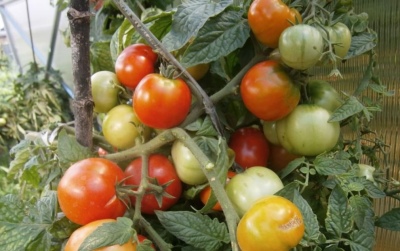
- Authors: Lukyanenko A. N., Dubinin S. V., Dubinina I. N. (Agrofirm Sedek LLC)
- Year of approval: 2010
- Category: grade
- Growth type: determinant
- Appointment: universal
- Ripening period: early
- Ripening time, days: 103-108
- Growing conditions: for open ground, for film greenhouses
- Bush size: undersized
- Bush height, cm: 40
It would hardly be correct to call June tomato a completely new plant - it has been known for quite some time. However, gardeners will only benefit if they become more familiar with this culture. And it's worth starting with a description of how it, in general, arose.
Breeding history
Such a tomato was developed by the Sedek agricultural company. Its creators - Lukyanenko A. N., Dubinin S. V. and Dubinina I. N. The main breeding work was carried out in the 2000s. Permission to grow such a plant in ordinary private gardens was given in 2010.
Description of the variety
This is one of the versatile tomatoes. It develops according to the determinant principle. Plants are undersized, bushes grow up to a maximum of 0.4 m. Branches appear rather weakly. Large green leaves develop on them, and the appearance of a trunk is also characteristic.
The main qualities of the fruit
Initially light green berries will turn red as they develop. The mass of such tomatoes ranges from 100 to 130 g. In shape, like many other tomatoes, they look like a flat circle and have only relatively fuzzy edges. Berries will traditionally appear on simple inflorescences. Another traditional feature for most varieties of tomatoes is the articulation of the stalk.
Taste characteristics
June tomato is sweetish. Its flesh is firm and fleshy. There are relatively few seeds in it. The peel of the fruit is firm, but does not leave a negative impression when eaten.
Ripening and fruiting
June tomato belongs to the group of early varieties. Between the discarding of the green shoots and the readiness of the berries for picking, an average of 103 to 108 days pass. The bush will bear fruit at a time and amicably. Therefore, gardeners must be on the lookout so as not to miss a critical moment.
Yield
The plant is distinguished by serious productivity. With high-quality agricultural technology, you can collect up to 7 kg of berries per 1 "square". In greenhouses, with very careful care, it is possible to bring the collection up to 10 kg of tomatoes. A similar result is possible throughout Russia, where it is allowed to grow this plant.
The timing of planting seedlings and planting in the ground
Sowing an early harvest should take place in February. This allows for optimal results. Backlighting is often used. Seeds are recommended to be thoroughly disinfected. There are no specific dates for transplanting into the ground, you should wait for good weather and warming up the earth.

Growing tomato seedlings is an extremely important process, because it largely depends on whether the gardener will be able to harvest at all. All aspects must be taken into account, from seedbed preparation to planting in the ground.
Landing scheme
You can plant 6, 7 or even 8 tomato bushes per 1 m2. The landing system is 700x300 or 700x400 mm. Such systems are chosen according to your taste.

Growing and care
There is no need to pinch such a tomato.Previously, the soil is saturated with manure and compost. Watering the bushes should be 2 to 5 times a week. If the heat is exhausting, irrigation is required every day. The use of growth stimulants activates the formation of ovaries.
Although removal of the stepchildren is not required, some growers still form 4-stem shrubs. It is possible to use organic fertilizers, but it doesn't make much sense. The picking of seedlings in containers is carried out after the appearance of 2 true leaves. Plants are strongly recommended to be hardened before planting in open ground. The duration of exposure to the open air is gradually increased.




A plant needs different micronutrients at each stage of growth. All fertilizers can be divided into two groups: mineral and organic. Folk remedies are often used: iodine, yeast, bird droppings, eggshells.
It is important to observe the rate and period of feeding. This also applies to folk remedies and organic fertilizers.
Disease and pest resistance
Protection against late blight is provided by the fact that the crop appears before the normal season of activation of the pathogen. Fruit cracking and verticillium damage are also unlikely.


Growing regions
It is possible to grow June tomato:
in Eastern and Western Siberia;
in the Urals;
in Moscow and Moscow region;
in the Volga and black earth regions;
in the North Caucasus;
in the Far East.
Review overview
Gardeners' evaluations of the June tomato are certainly favorable. It is noted in many cases that, even under unfavorable growing conditions, it gives good results. The survival rate of plants is quite high. The fruits are indeed plentiful and tasty. For a positive outcome of the season, very little effort will be required.

























































































